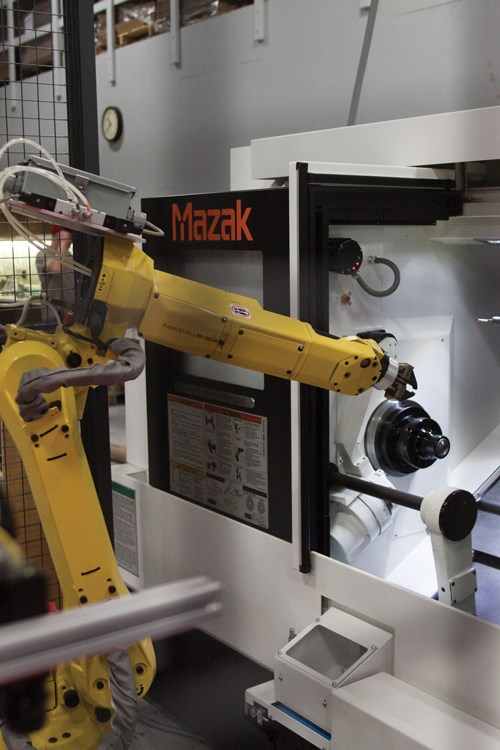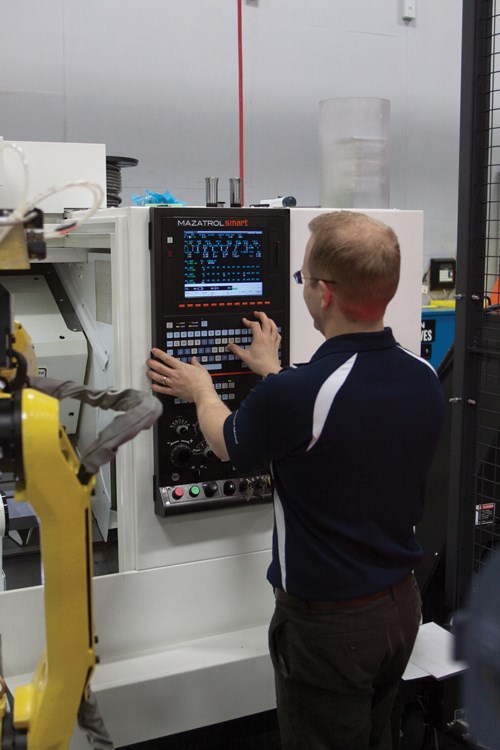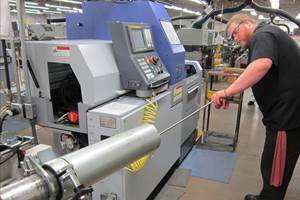Shop Gains Process Control with Automation
Eliminating variability from the manufacturing flow is a goal for most shops. Automation can allow reallocation of resources to accomplish this.
Instead of eliminating the human element from part manufacturing operations, Stark Industrial LLC, located in North Canton, Ohio, incorporates automation to achieve part processing control. Automation allows the shop’s highly trained machinists to focus more on inspection and other critical operations rather than consuming their valuable skills and time on menial tasks such as loading and unloading machines.
Automation at the company has typically involved basic effective systems such as bar feeders, parts catchers and machine tool pallet-changing capability along with automatic in-process gaging. But recently, the shop took automation a step further with the installation of its first stand-alone robot that works within a new turning machine cell.
The new cell is currently dedicated to processing a cast aerospace part that is proprietary—so much so that no one outside of the company is permitted to see it. With the cell, the shop delivers, on a weekly basis, 2,000 completed parts required to keep the customer’s manufacturing operations continuously running. And the job’s required volumes are expected to increase in the near future.
Stark Industrial started in 1959 as a distributor of industrial equipment, and by the 1970s transformed into a contract manufacturer. Today, with 38 employees and about 24 CNC machines, the shop provides part machining and subassembly work for customers in the aerospace, medical, power generation, oil and gas and food processing equipment industries. Manufacturing processes include milling, turning, EDM, small-hole drilling and grinding, along with complementary operations such as welding, brazing and sand blasting.
New Job, New Approach
When first approached with the aerospace job, Stark Industrial knew that automation would allow it to meet the required quantities and consistently produce accurate parts. But it also realized that the cell had to work completely unattended because the part’s simple machining operations didn’t require the skills of a highly trained machinist or the capabilities of an extremely complex machine tool. However, the machine had to be dependable, fast, accurate and allow for easy robot integration.
At the heart of the company’s new automated cell is a Quick Turn Smart 200 two-axis turning center from Mazak Corp. that includes a Fanuc M-10iA robot and iRvision system. The machine features an NC tailstock, automatic tool eye, 2.99-inch spindle bore, collet chuck, 12-station tool turret and automatic parts catcher. For in-process part gaging, the shop equipped the machine with a Renishaw probe. Additionally, there is a parts catcher and conveyor system with a standalone cutoff and grinding station within the cell.
The new turning center adds to the overall production speed and accuracy of the cell by cutting the aerospace parts in quick, 70-second cycle times and providing continuous machining accuracy within 0.0002 inch. And as a whole, the cell not only provides complete process control and improves part quality consistency, but also combines and automates multiple processes that were previously done by two separate vendors—eliminating time wasted transporting parts from one vendor facility to another.
According to Jonathan Wilkof, manufacturing engineer at Stark Industrial, the shop’s Quick Turn 200 turning center is the second of two such existing machines in the field
that incorporate Mazak’s optional built-in robot interface. He says the interface allows the machine to seamlessly communicate with the robot, making it easy to program the robot through simple M codes within the machine’s CNC control, which uses both EIA/ISO format programs and conversational programming.
As part of the interface, there are two data links with 37 I/O channels each for back and forth communication, along with several built-in safety parameters and conditions that the machine initiates prior to the robot entering the work envelope. For instance, the machine will automatically ensure that its door is open, the tailstock, tool-eye and parts catcher are retracted and its chuck is open.
Additionally, the interface gives the company automatic tool offsetting capabilities in conjunction with its in-process part probing. As cutting tools wear, the machine automatically compensates for it, and once a predetermined amount of compensation has been reached, the machine indexes its tool turret to apply a new tool/insert to the workpiece.
“Mazak’s optional interface is full featured and comes supplied with the necessary software,” Jonathan says. “The company was really instrumental in walking us through how the interface works, and as this was our first such robot interface, it provided a lot of best-practice advice to quickly get us up and running.”
Automated Cell in Action
The proprietary aerospace cast components being processed in Stark Industrial’s new automated cell are small and made from a special high temperature aerospace alloy. They measure about 1.500 inches long and require an OD that tapers from 0.500 inch in diameter as small as 0.125 inch. But the fact that the parts are castings makes the job a challenge.
According to Sam Wilkof, vice president of Stark Industrial and Jonathan’s father, the customer supplies the castings, which often arrive in unusual conditions. Raw castings can be bent, warped and have excess flashing. Plus, metallurgically, there can be permutations because of the part’s small size. All of these conditions must be dealt with in the cell, which is why robot vision is so critical, as is the accuracy of the robot itself and the machine tool.
The automated cell performs three operations to produce a complete part: cutoff, grinding and OD turning. And when parts exit the cell, all their surfaces, except where the part is gripped for turning, are machined.
Parts enter the cell via a conveyor and run under the vision system to a shaker table where the robot picks one up, moves it to the cutoff and grinding station and performs those operations. The machine’s door and collet chuck automatically open, and the robot loads the part for the turning operation, which is the final one in the part process.
The Quick Turn’s collet chuck grips only 0.150 inch of the part. And because a collet is being used for workholding, robot movement must be precise when loading a part. Jonathan says the shop tried different types of workholding, but being a completely automated cell and running 2,000 pieces per week, the job required the consistent accuracy and extreme durability of collets.
Flexible Probing
During the turning operation, the machine runs roughing and finishing passes to machine the part’s tapered OD. At certain intervals, the machine will initiate an automatic probe of the part for inspection and tool offsetting purposes. The part’s taper must be held to within ±0.5 degree and other tolerances to ±0.005 inch. However, automatic part probing can be a challenge, again because the part is a casting.
Often, OD part surfaces will not entirely clean up, so there may be low spots, which are completely permissible. Unfortunately, automatic probing can read these low spots and indicate an out-of-tolerance part when that is not actually the case. To ensure accurate readings, the turning center is programmed to run a special probing cycle that will locate a fully machined area and then probe at two points along the taper for calculating the actual taper.
Once the turning operation is complete, the turning machine’s spring plunger behind the collet pushes the part out as the parts catcher rises to accept it. Parts then move to the conveyor that takes them outside the cell and into a bin. While this is happening, the robot is poised and ready at the machine to load the next part.
Production and Automation
According to Jonathan, the shop focuses on prototype quantity jobs to those involving production volumes of as many as 100,000 pieces, with the larger quantity jobs often spread over certain time periods. For these long-term jobs, the shop must control the amount of parts produced at a time while simultaneously maintaining a steady flow of parts shipped to the customer to keep their manufacturing operations running.
“Job scheduling depends on part complexity,” Jonathan says. “If a part has a 10-second cycle time, we’ll produce a lot of them in a short period of time and keep them on hand for the next scheduled delivery interval. But most of our parts have complex features and require multiple setups and tight tolerances, so we may run only 25 at time. To effectively schedule and track jobs and satisfy all customer delivery requirements, we rely heavily on a shop management system from E2 Systems.”
In addition to its cross-trained employees that easily move from one type of machine to another as needs arise, Stark Industrial depends on the use of basic automation on some of its machine tools to adapt to ever-changing production schedules and meet tight delivery times.
“Our types of automation are common for those shops doing higher volume jobs. But in our minds, automation is a tool for making better parts,” Sam says. “Plus, it allows us to apply the talents of our skilled machinists to the more complex jobs because automation is handling the less complicated ones. We have no ‘secret’ equipment or custom-built machines. All the equipment on our shop floor is commonly available. But it is how we use the equipment, along with the talents of our machinists, that is unique and key to our success.”
In Control
And according to Jonathan, the shop’s Mazak CNCs enhance the ability of machinists to comfortably move from machine to machine as production requirements dictate (the company has ten Mazak machines). “From very early on, we have always realized the quality and ‘universal nature’ of these controls. And while control technology grows more advanced from generation to generation, the differences are not that drastic, which allows our machinists to easily adapt and identify with each new control version.”
Jonathan went on to say that Mazak always maintains several common screens and methodologies across all the versions of its CNCs. And with that commonality, he explained that the shop often programs at the machines. The shop off-line programs some jobs, but according to Jonathan, most are done at the machines because the controls are sufficiently fast and powerful.
“We look for extremely dependable machine tools that are quick to set up, provide us with multiple operations capability, are easy to program and automation ready in some form or another. Plus, the machines must be backed by strong technical support,” Jonathan says. “We only incorporate machines that further our processing capabilities and expand the range of parts types we can produce, yet make us competitive in doing so.”
Related Content
CAM-Driven Lathe Questions
There can be hidden issues using legacy cam-driven lathes that can be overcome using new CNC technology. Here are three to keep in mind.
Read MoreGetting More Production From Swiss Turning Centers
Buying a new CNC Swiss turning center is a substantial investment. For the best return, look closely for capabilities that enable the best utilization of the machine.
Read More6 Tips for Training on a Swiss-Type Lathe
There are nuances to training a person to effectively operate a Swiss-type lathe. A shop I visited a while back offers some suggestions.
Read More5-Axis Machining Centers Transform Medical Swiss Shop
Traditionally a Swiss machine shop, Swiss Precision Machining Inc. discovers a five-axis machining center that has led the company to substantial growth. (Includes video.)
Read MoreRead Next
Robotic Automation's Challenges, Solutions and Benefits
This article looks at considerations for implementing robotic automation.
Read MoreDo You Have Single Points of Failure?
Plans need to be in place before a catastrophic event occurs.
Read MoreEmerging Leaders Nominations Now Open
Here’s your chance to highlight a young person in your manufacturing business who is on the path to be a future leader moving your company forward.
Read More












.jpg;maxWidth=300;quality=90)












